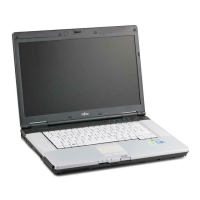Security functions
Trusted Platform Module (TPM) (device-dependent)
TPMTrustedPlatform Module
To use the TPM, you must activate the TPM in the BIOS Setup before the software
is installed. The condition for this is that you have assigned at least the superviso r
HDD password (see "
Securit y functions", Page 53).
Enabling TPM
• Requirement: You have assigned a supervisor HDD password, see "Security functions" , Page 53.
► Call up the BIO S Setup an
d select the Sec urity menu.
► Mark the TPM (Security Chip) S etting field and press the Enter key.
► Select the “Security C
hip” “Enabled” entry to activate the TPM.
Once you have activated the TPM through a reboot, the Clea r Sec urity Ch ip option appears.
With Clear Security C
hip, you can delete the owner in the TPM, if the TPM has already
been used. With Enab
led, all secret keys (e.g. SRK - Storage Root Keys, AIK -
Attestation Ident
ity K eys etc.) generated by applications are deleted.
Please note that yo
u will then no longer be able to access the data you have
encrypted with th
e keys based on that holder.
► Select the Exit Sa
ving Changes option in the Exit menu.
► Press the Enter key and select Ye s .
The notebook w il
l resta rt, and TPM will be enabled after the reboot.
Disabling TPM
• Requirement: You have assigned a supervisor HDD password, see "Security functions" , Page 53.
► Call up the BIOS Setup and select the Security menu.
► Mark the TPM (Security Chip) S etting field and press the Enter key.
► Select “S ecu rity Chip ” “Disabled” to deactivate the TPM.
► From the Exit menu, choose the option Exit Saving Changes.
► Press the Enter key and select Ye s .
Your notebook will now restart and TPM will be disabled.
Fujitsu 57

